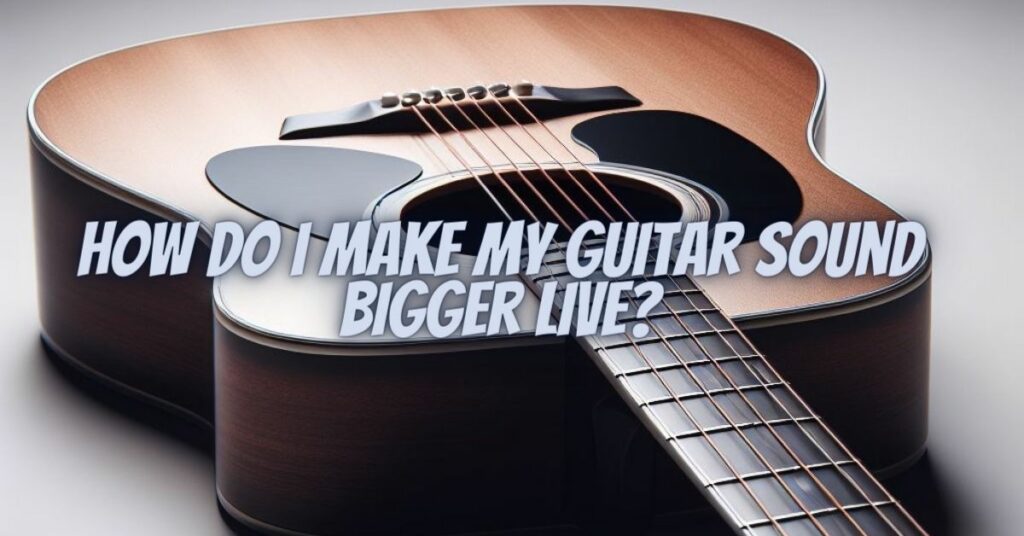When performing live, guitarists often strive to create a powerful and expansive guitar sound that captivates the audience. Achieving a bigger, more expansive sound can elevate your live performance and make your guitar stand out in the mix. In this article, we will explore a range of techniques and tips to help you make your guitar sound bigger and more impressive when performing live.
- Choose the Right Guitar
The choice of guitar plays a significant role in achieving a larger live sound. Consider the following factors:
- Semi-Hollow or Hollow-Body Guitars: These guitars can produce a rich, resonant tone with more natural sustain, making them ideal for creating a fuller sound.
- Larger Body Shapes: Guitars with larger body shapes, such as jumbo or dreadnought acoustic guitars, can project a bigger sound due to their increased soundboard area.
- Amplification and Signal Chain
Your amplifier and signal chain have a substantial impact on your live sound:
- Amp Selection: Choose an amplifier with sufficient power and headroom to fill the performance space. A higher wattage amp can provide cleaner, more robust tones at higher volumes.
- Pedals and Effects: Use effects pedals strategically to enhance your sound. Reverb, delay, and modulation effects can add depth and spaciousness to your tone.
- EQ and Tone Shaping: Experiment with your amp’s EQ settings to find the right balance. Boosting the mids and dialing in a touch of bass can help create a fuller sound.
- Playing Techniques
Your playing techniques can significantly impact the perceived size of your guitar sound:
- Dynamic Range: Vary your playing dynamics to create contrasts in volume and intensity. Incorporate softer, cleaner passages followed by more aggressive, powerful sections.
- Chords and Voicings: Experiment with chord voicings that incorporate open strings and larger intervals to create a richer and more harmonically complex sound.
- Use of Octaves and Doubling: Employ octave or unison doubling effects to thicken your sound, making it more prominent in the mix.
- Mic Placement
If you’re using microphones to amplify your guitar, proper mic placement is crucial:
- Experiment with Mic Position: Try different microphone placements in front of your amplifier or acoustic guitar. Moving the mic closer to the sound source can capture more nuances, while placing it slightly off-center can add depth.
- Combining Microphones: Using multiple microphones, such as a combination of a dynamic and a condenser mic, can capture a wider frequency range and create a bigger sound.
- Mixing and Sound Engineering
Collaborating with a sound engineer can be invaluable for achieving a bigger live sound:
- Communication: Clearly communicate your desired sound to the engineer, and be open to their expertise and suggestions.
- Monitor Mix: Ensure that you have a dedicated monitor mix that allows you to hear yourself and the band clearly. A well-balanced monitor mix can help you perform with confidence.
- Feedback Management: Work with the engineer to manage any potential feedback issues, especially when playing at high volumes.
- Room Acoustics and Venue
Consider the acoustic properties of the venue and adapt your sound accordingly:
- Venue Size: Adjust your sound to fit the size of the venue. In larger spaces, you may need more amplification and effects to fill the room.
- Acoustic Treatment: If possible, make use of acoustic treatment in the venue, such as sound-absorbing panels and diffusers, to improve sound dispersion and clarity.
- Stage Presence and Confidence
Confidence and stage presence play a significant role in how your guitar sound is perceived:
- Performance Energy: Engage with the audience and channel your energy into your playing. A dynamic and passionate performance can make your sound feel bigger.
- Stage Movement: Move around the stage purposefully, and position yourself where your sound projects effectively to the audience.
Making your guitar sound bigger live is a combination of factors, from instrument choice and amplification to playing techniques and stage presence. By carefully considering these elements and continually refining your approach, you can achieve a powerful and expansive guitar sound that captivates your audience and elevates your live performances to new heights. Experimentation, practice, and collaboration with sound engineers are essential steps on your journey to achieving a bigger live sound.


